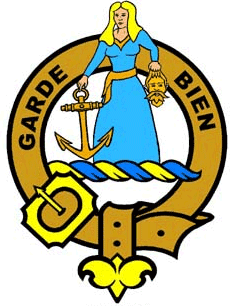Montgomery Clan
Montgomery Clan Crest: A lady, anciently attired in blue, holding an anchor in the dexter hand and the head of a savage by the hair in the sinister.
Montgomery Clan Motto: Garde Bien (Guard well).
History of Clan Montgomery:
Roger de Montgomerie, born around the year 1030 at Lisieux in Normandy, was Joint-Regent of Normandy when William the Conqueror invaded England in 1066. He was created Earl of Arundel, and from his family comes
the County of Montgomeryshire in Wales. The first of the name recorded in Scotland was Robert de Mundergumri, who obtained a grant of the Manor Eaglesham in Renfrewshire in the 12th century. His name also features as
a witness on various Charters issued by Walter FitzAlan between 1165 and 1177. In all probability, this Robert accompanied Walter Fitz-Alan, ancestor of the Stewart kings, to Scotland with David I.
A century later, John de Montgomery and his brother gave homage to Edward I of England. In the next century, however, another Sir John de Montgomery, 7th Baron of Eaglesham, captured Sir Henry Percy, known as “Hotspur” at the Battle of Otterburn in 1388. With the proceeds of the ransom money, the Montgomerys built their great castle of Polnoon at Eaglesham, only traces of which now remain.
Sir John married the daughter and heiress of Sir Hugh Eglinton and the family acquired the Barony of Eglinton and Ardrossan. Their grandson Alexander was created Lord Montgomery. For supporting James IV at the Battle of Sauchieburn in 1488, he was granted the Isle of Arran, made Keeper of Brodick Castle and Baillie of Bute and Cunningham, which sparked off a conflict with the Cunninghams of Glencairn.
After the death of James IV at the Battle of Flodden in 1513, Sir Alexander was nominated one of the Queen-Dowager's Councillors and made Earl of Eglinton. His grandson, the 3rd Earl, a devout Catholic, became a firm supporter Mary Queen of Scots.
Later in the 16th century, the feud with the Cunninghams took a violent turn when the 4th Earl of Eglinton was shot in a skirmish between the two clans which led to a massacre of the perpetrators of the deed. With the death of the 5th Earl in 1615, a favourite of James IV, the male line of the Montgomerys became extinct. However, the daughter of the 3rd Earl had married Robert Seton, 1st Earl of Winton, and, on the 5th Earl of Eglinton's death, their younger son, Sir Alexander Seton of Foulstruther, a Covenanter, became 6th Earl of Eglinton and took the surname of Montgomery.
In 1840, the 13th Earl of Eglinton was recognised as heir male to the 4th Earl of Winton, a title which had been forfeited by his kinsman George Seton who was accused of treason following the Battle of Preston. It was the 13th Earl of Eglinton who had organised the mediaeval Eglinton Tournament held at Eglinton Castle during a rain storm in 1839. Much ridiculed for its expense (costing between £30,000 and £40,000), Prince Louis Napoleon was one of the participants, and the future Duchess of Somerset was the Queen of Beauty.
Alexander Montgomery (1550-1602) was a poet at the Court of James VI, best known for writing The Cherry and the Slae. Sir James Montgomery of Skelmorlie(d.1694) was Member of Parliament for Ayrshire and imprisoned for sheltering Covenanters. He organised a political group known as The Club. Sir James William Montgomery (1721-1803) became Lord Advocate in 1766, and Chief Baron of the Exchequer in 1775. Bernard Montgomery, Viscount Montgomery of Alamein (1887-1976), popularly known as 'Monty', was a hero commander of British troops during the Second World War.
Surname distribution in Scotland: The Montgomery name is most commonly found in Ayrshire, the Western Isles, Dumfries and Galloway (Dumfriesshire, Kirkcudbrightshire and Wigtownshire), Glasgow City, Dunbartonshire, Renfrewshire, Argyll and Bute and Orkney.
Places of Interest:
Eaglesham, Renfrewshire. Manor granted to Robert de Mundegumeri in 12th century; retained by the family for 700 years.
Eglinton Castle, Irvine, Ayrshire. Built in 1798, but abandoned in 1920. The roof was taken off in 1925 and it is now a complete ruin.
Skelmorlie Castle, Largs, Ayrshire. Restored in 1798, the oldest part dates from 1502.
Largs, Ayrshire. The church yard here contains a statue of Sir Robert Montgomerie (d.1651).
Clan Montgomery members display Prints.

